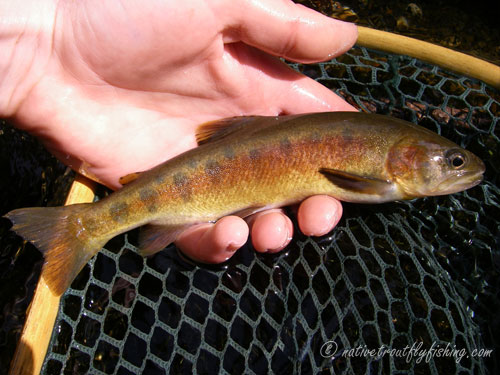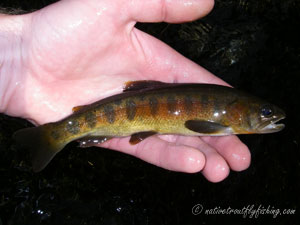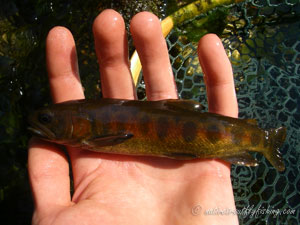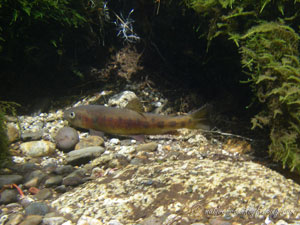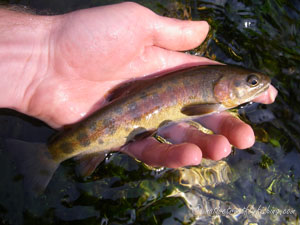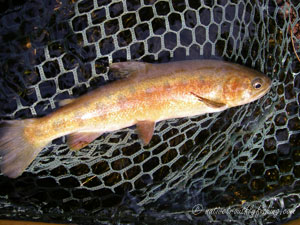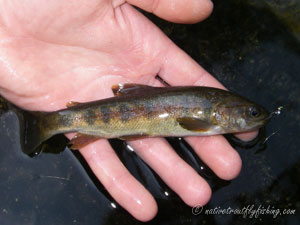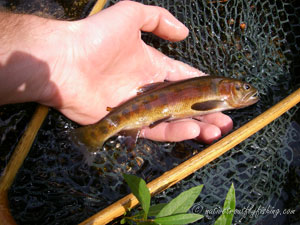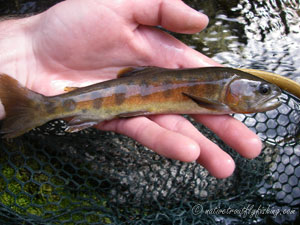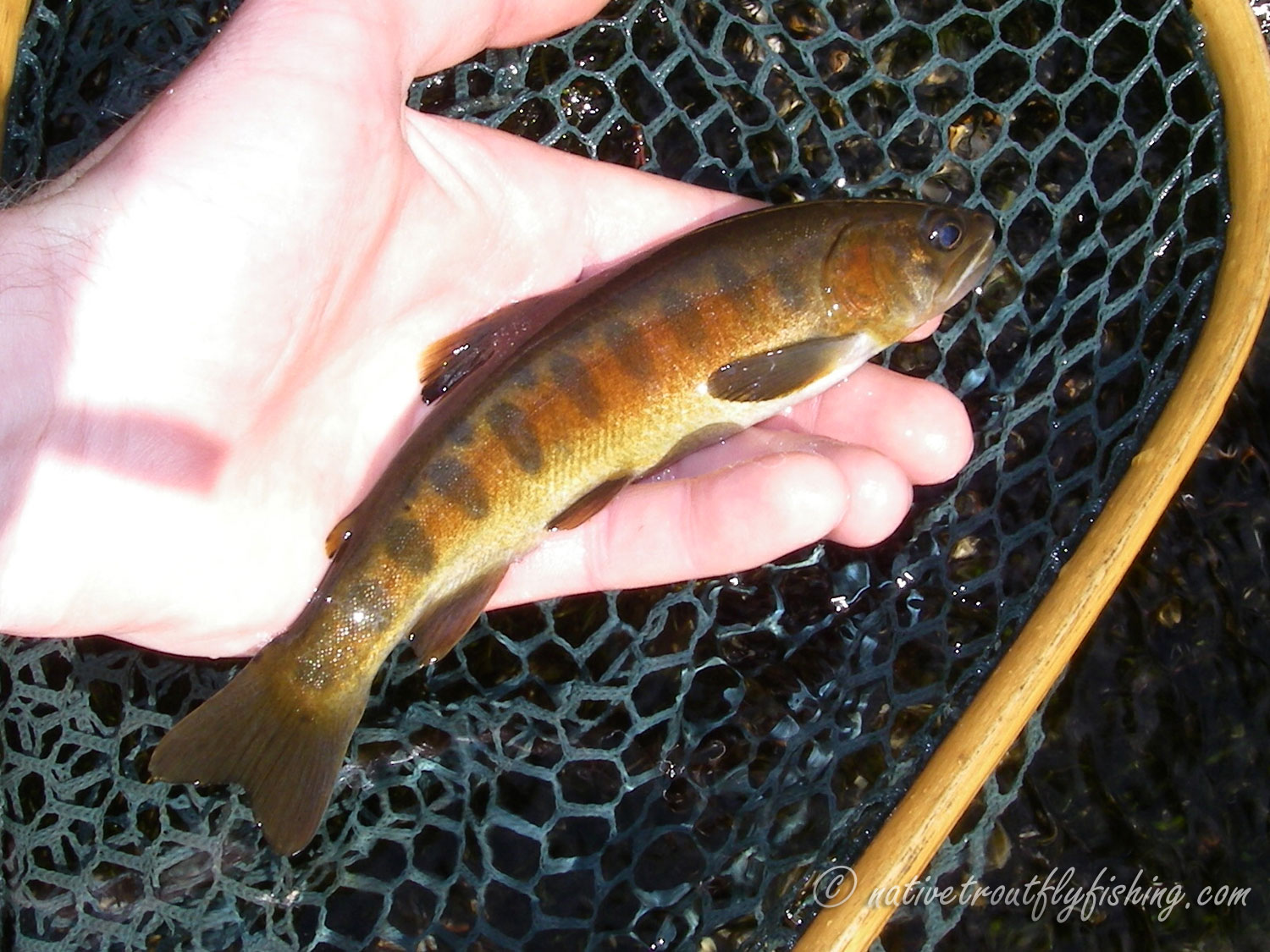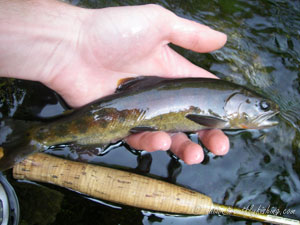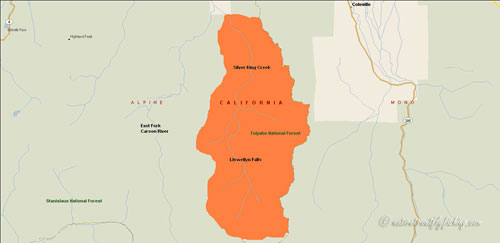Paiute Cutthroat
Oncorhynchus henshawi seleniris
A Paiute Cutthroat from a small stream in California.
Introduction
The Paiute Cutthroat is a subspecies of Lahontan Cutthroat Trout and considered one of the rarest trout in North America, as it historically was only native to 9.1 miles (14.7km) of Silver King Creek, a tributary to the Carson River in California. Due to their limited native range and the California Department of Fish and Wildlife (CDFW) has established four refuge populations outside of their native range in case of the loss of the Silver King Creek population. The Paiute Cutthroat is distinguished from other cutthroat subspecies by an absence of spots on its body and genetics show that it is genetically distinct from other Cutthroat in the Lahontan basin, but is most closely related to Humboldt Ctthroat (Saglam et al. 2017). It is thought that these fish were isolated in Silver King Creek during a period of high water in ancient Lake Lahontan, which likely occurred during the last ice age. These trout have only narrowly escaped extinction in recent times and finally reintroduced into their native range on Silver King Creek in September of 2019.
Life History Information
Paiute Cutthroat are native to one small high elevation stream and historically only exhibited a stream resident life history (Behnke 2002). Like other Cutthroat spawning takes place in the spring to early summer (June-July). Paiute Cutthroat typically reach sexual maturity around age two or three and although they are iteroparous they rarely survive their first spawning event. Wong (1991) showed that only 3.8 percent of Paiute Cutthroat in one of the transplanted Paiute populations survived past age three, with a few fish surviving to age five or six. The average female lays between 50 and 300 eggs and the fry generally emerging from the gravel after around 8 to 10 weeks depending on stream temperatures (Trotter 2008). After emergence fry seek out intermittent tributaries or backwater areas until they are about 2 inches long (5 cm) (Diana and Lane 1978). Once large enough Paiutes establish and defend territories to ensure access to food and do not typically stray very far with migrations of up to 0.6 miles (1 km) being reported (Diana and Lane 1978). Adults seek out pool habitat in low gradient meadows with undercut banks and good riparian cover. Like other stream resident trout Paiutes are opportunistic drift feeders with a diet consisting primarily of aquatic and terrestrial insects and generally reach a maximum size of 8 to 10 inches (20 to 25 cm). While there are no lakes within the native range of Paiute Cutthroat, when stocked into in Birchim Lake, California in 1957, Paiutes were able to adapt and reach a size of 18 inches (46 cm). Unfortunately, the Birchim Lake population was lost to hybridization with Rainbow Trout, which were also stocked in the drainage.
Status
The Paiute Cutthroat has one of the smallest native ranges of any North American trout at just 9.1 miles (14.7 km). With its limited range, the Paiute Cutthroat is vulnerable to extinction and was only re-established within its native range in 2019. The Paiute Cutthroat was historically native to Silver King Creek above a series of falls in a canyon just upstream of Snodgrass Creek to Llewellyn Falls. However, they were eliminated from all their native habitat by hybridization with introduced Rainbow Trout, Golden Trout and Lahontan Cutthroat Trout. If it had not been for one or more unofficial transplants of these fish above Llewellyn Falls in 1912 by Basque shepherds, they would be extinct today (Behnke 1992). In 1967, the Paiute Cutthroat was listed as endangered under newly enacted Endangered Species Preservation Act (USFWS 1967), but by 1975, they were downlisted to threatened under the 1973 Endangered Species Act (ESA) to facilitate restoration efforts (USFWS 1975, USFWS 2004, USFWS 2013).
The greatest threat to Paiute Cutthroat has been the introduction of non-native salmonids within their native range. Since Paiute Cutthroat did not evolve with other salmonids, they are susceptible to competition and hybridization. In additional to interactions with non-native fish species, Paiute Cutthroat have also been negatively impacted by overfishing and habitat degradation. Historically overfishing has been a problem as Paiute Cutthroat have few natural predators they are highly susceptible to angling. Currently Silver King Creek is closed to all angling to both protect the existing populations and enable recovery efforts to proceed. Habitat degradation has also been an issue in the watershed as the Silver King Creek basin has been used extensively for grazing for the past 100 years. Livestock grazing impacts these fish is by leading to a loss of riparian vegetation, downcutting of the stream channel and adding excessive loads of fine sediments into the streams (Kondolf 1994). This is especially detrimental to the survival of eggs as fine sediments smother them causing the embryos to suffocate. Another issue in the Silver King Creek basin has been the presence of beavers, which are not native but were introduced to the east slope of the Sierra Nevada Mountains for trapping purposes. Willow and aspen growth in the Silver King basin is not sufficient to maintain a permanent beaver colony and as such, dams are usually abandoned after a few years (USFWS 2004). After the beavers leave, the dams block spawning movements and the ponds behind them fill with silt and wash out when not maintained resulting silt in of redds and down-cutting of stream channels and can cause up to a 10-fold reduction in Paiute Cutthroat numbers (Trotter 2008).
For a time, Paiute Cutthroat remained secure above Llewellyn Falls, but sometime after 1950, several stockings Lahontan Cutthroat and Rainbow Trout resulted in hybridization of the populations above the falls. Since then, efforts to restore pure Paiute Cutthroat have been underway, which has included eradicating the non-native trout and hybrids above the falls and creating several safety net populations in formerly fishless streams outside of the native range of the Paiute Cutthroat. Recent genetic testing has confirmed that the eradication efforts above Llewellyn Falls were successful as no hybrids were detected (Cordes et al. 2004). Starting in the 2000ís the CDFW developed a plan to remove all non- native trout from native range of the Paiute Cutthroat in Silver Creek below Llewellyn Falls. However, this plan was held up for over a decade due to legal challenges regarding the use of rotenone to treat the stream (CDFG 2009). After submitting a formal Environmental Impact Statement (USFWS and CDFG 2010), Silver King Creek was treated with rotenone between 2013 and 2015. The stream was allowed several years (2016-2018) to verify that all non-native trout had been removed and on September 18, 2019 Paiute Cutthroat were reintroduced below Llewellyn Falls after nearly 100 years absence.
Description
The Paiute Cutthroat is nearly identical in appearance to the Lahontan Cutthroat except for their spotting pattern. This distinguishes Paiute Cutthroat from all other North American trout, as they are the only trout lacking any body spots. These trout may have some spots on their dorsal, adipose, and caudal fins and while they lack body spots, parr marks are often retained into adulthood. The coloration of the Paiute Cutthroat tends to be a brownish olive on the back transitioning to a yellowish color along their sides and white along the belly. These trout typically exhibit a reddish colored band along their lateral line and the same color on their gill plates.
Stream Resident Form
Click on images to view a larger picture
Native Range
A map of the original native range of the Paiute Cutthroat trout. Data Source: Behnke (2002) and Trotter (2008).
References
Behnke, R. J. 1992. Native trout of western North America. American Fisheries Society Monograph 6. American Fisheries Society, Bethesda, Maryland.
Behnke, R.J. 2002. Trout and Salmon of North America. Chanticleer Press, New York.
CDFG. 2009. Paiute cutthroat trout restoration project Silver King Creek, Humboldt-Toiyabe National Forest, Alpine County, California. California Department of Fish and Game, Rancho Cordova, CA.
Cordes, J.F., J.A. Israel and B. May. 2004. Conservation of paiute cutthroat trout: the genetic legacy of population transplants in an endemic California salmonid. California Fish and Game 90(3): 101-118.
Diana, J.S. and E.D. Lane. 1978. The movement and distribution of Paiute cutthroat trout, Salmo clarki seleniris, in Cottonwood Creek, California. Transactions of the American Fisheries Society 107(3): 444-448.
Kondolf, G.M. 1994. Livestock grazing and habitat for a threatened species: land-use decisions under scientific uncertainty in the White Mountains, California, USA. Environmental Management 18(4): 501-509.
Saglam, I.K., D.J. Prince , M. Meek, O.A. Ali, M.R. Miller, M. Peacock, H. Neville, A. Goodbla, C. Mellison, W. Somer, B. May and A.J. Finger. 2017. Genomic analysis reveals genetic distinctiveness of the Paiute Cutthroat Trout (Oncorhynchus clarkii seleniris). Transactions of the American Fisheries Society 146(6): 1291-1302.
Trotter, P. 2008. Cutthroat: Native Trout of the West. Second Edition. University of California Press, Berkley, CA.
USFWS. 1967. Native fish and wildlife: Endangered species. Federal Register 32:4001. March 11, 1967.
USFWS. 1975. Threatened status for three species of trout. Federal Register 40:29863-29864. July 16, 1975.
USFWS. 2004. Revised recovery plan for the Paiute cutthroat trout (Oncorhynchus clarki seleniris). United States Fish and Wildlife Service, Portland, OR.
USFWS and CDFD. 2010. Paiute cutthroat trout restoration project: Silver King Creek, Humboldt-Toiyabe National Forest, Alpine County, California. Final Environmental Impact Statement EPA No. FES 10-10.
Wong, D.M. 1991. Life history and management of Paiute cutthroat trout in the White Mountains, Mono County, California. Animal Biology 182-190.
Contact
Feel free to contact me if you have any questions or comments
Paiute Cutthroat Trout Links
California Department of Fish and Wildlife - California Paiute Cutthroat Trout Angling
U.S. Carson-Iceberg Wilderness Area
Western Native Trout Initiative - Paiute Cutthroat Trout
Native Trout Links
Truchas Mexicanas' - Native Trout of Mexico
Balkan Trout Restoration Group
Trout and Seasons of the Mountain Village - About Japanese Trout
Western Native Trout Challenge
California Heritage Trout Challenge
Fly Fishing Blogs
Dave B's Blog: Fly Fishing for Native Trout
The Search for Native Salmonids
Conservation Links
Western Native Trout Initiative
Fly Fishing Links
Fishing Art Links
Americanfishes.com - Joseph R. Tomelleri
Fish Eye Guy - Underwater Trout and Salmon Pictures
